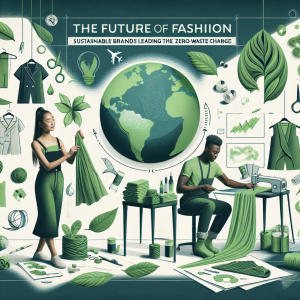Sustainable fashion is transforming the clothing and textile industry, steering it towards more eco-friendly and ethical practices. This revolution is reshaping how fashion is designed, produced, consumed, and disposed of, aligning the objectives of style and sustainability. As the fashion industry is one of the largest contributors to pollution, this shift not only caters to environmental needs but also advocates for social equity and economic inclusivity.
The heart of sustainable fashion lies in using eco-friendly materials. Organic cotton, hemp, bamboo, and recycled fibers are just a few of the materials that brands now favor over conventional fabrics. Organic cotton, for instance, eliminates the need for harmful pesticides and fertilizers, preserving soil health and reducing water consumption significantly. Hemp grows quickly and requires minimal water, thriving without the need for chemicals. Recycled fibers, fashioned from post-consumer waste such as plastic bottles, reduce landfill waste and conserve resources.
Beyond materials, ethical production processes have become crucial elements of sustainable fashion. Brands now prioritize responsible manufacturing practices, ensuring fair wages and safe working conditions. This approach counters the dark history of labor exploitation often associated with the fashion industry. Consequently, transparency has become a key consideration, with brands offering insights into their supply chains and the working environments of their employees. Certifications like Fair Trade and the Global Organic Textile Standard (GOTS) help consumers identify genuinely ethical brands, supporting informed purchasing decisions.
Furthermore, the concept of a circular economy is gaining traction in the fashion industry. Unlike the traditional linear model—where clothes are made, used, and then discarded—circular fashion emphasizes reducing waste through recycling and reuse. Brands are finding innovative ways to reclaim products at the end of their lifecycle, transforming them into new garments. Repair, resale, and rental services are burgeoning, extending the lifespan of clothing and diminishing the demand for endlessly new products.
Fashion’s sustainability revolution also taps into the rise of slow fashion, an antithesis to the fast fashion trend that prioritizes quantity over quality. Slow fashion emphasizes thoughtful purchasing, encouraging consumers to invest in fewer, high-quality items that last longer. This shift not only reduces environmental impact but also fosters a deeper connection between consumers and their clothing, as they appreciate craftsmanship and longevity over fleeting trends.
Technological advancements are crucial in driving the sustainable fashion movement forward. Innovations such as 3D printing, digital textiles, and biofabrication are paving the way for more sustainable production methods. 3D printing reduces waste by creating garments on-demand, tailored to specific measurements, eliminating excess fabric waste. Digital textiles use nanotechnology and smart fibers to create functional clothing that needs less frequent washing, saving water and energy.
Consumer awareness plays a pivotal role in the success of sustainable fashion. As shoppers become more conscious of their ecological footprint, they demand accountability from brands. Social media and online platforms provide them with tools to research and engage with brands, fostering a culture of transparency and accountability. Influencers and celebrities, leveraging their platforms, help amplify the message of sustainability, encouraging fans to make conscientious choices.
Designers play an integral part in this revolution, as well. By integrating sustainability into their creative process, they challenge the status quo, viewing sustainable fashion not as a limitation, but an opportunity. This innovative thinking inspires unique designs that capture consumers’ imaginations while adhering to ethical standards.
One cannot overlook the economic implications of sustainable fashion. While initially perceived as costly, sustainable practices potentially reduce expenses over time. Efficient use of resources, waste reduction, and innovative materials often lower production costs in the long run. Additionally, as demand rises, economies of scale can drive prices down, making sustainable fashion accessible to a broader audience.
Meanwhile, consumer education is crucial in demystifying the care and longevity of sustainable garments. Many brands now offer guidance on how to care for natural fibers, encouraging practices that extend the life of clothing while minimizing environmental impact. Easy-to-follow care instructions, repairs, and DIY upcycling ideas enable consumers to take stewardship of their wardrobes.
Government policy and international cooperation also play a significant role in catalyzing the industry’s transition to sustainability. Legislation on corporate responsibility, waste management, and pollution control pressures companies to adopt greener practices. Programs such as the EU’s Green Deal and China’s Green Textile Roadmap exemplify global initiatives urging the industry to comply with sustainable standards and practices.
Collaboration across sectors amplifies the movement toward sustainable fashion. Partnerships between NGOs, governments, academia, and private enterprises are vital in promoting research, development, and education. These collaborations foster progress and innovation, ensuring sustainable fashion is more than a trend but a transformative force.
The media’s role in promoting sustainable fashion is substantial, as it shapes public perception and awareness. Documentaries, articles, and blogs spotlight the damaging effects of fast fashion and the benefits of sustainable alternatives. This consistent flow of information nurtures a more knowledgeable consumer base, aligning public sentiment with sustainability values.
Retailers, too, are pivotal in driving change by altering the way they present and sell products. By allocating space to sustainable lines and educating consumers about the benefits, they integrate eco-friendly fashion into mainstream shopping experiences. Some retailers have taken the extra step by implementing take-back programs, offering discounts in exchange for old clothes to encourage recycling.
While challenges remain, such as greenwashing and supply chain complexities, advancements in policy, education, and practice continue to steer the industry towards greater sustainability. As fashion evolves, embracing sustainability isn’t merely an option; it’s a necessity that ensures the industry can thrive harmoniously with the planet.



